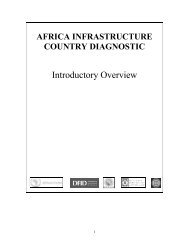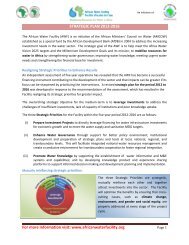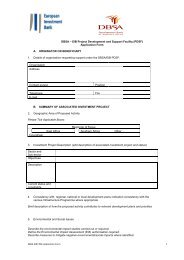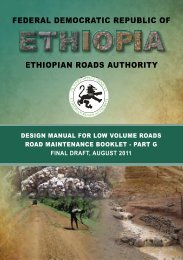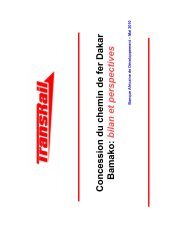Design-Manual-for-Low-Volume-Roads-Part-A
Design-Manual-for-Low-Volume-Roads-Part-A
Design-Manual-for-Low-Volume-Roads-Part-A
You also want an ePaper? Increase the reach of your titles
YUMPU automatically turns print PDFs into web optimized ePapers that Google loves.
A - Chapter 1 - 1<br />
1.<br />
CONTEXT AND SCOPE OF THE LOW<br />
VOLUME ROADS MANUAL<br />
This <strong>Low</strong> <strong>Volume</strong> <strong>Roads</strong> <strong>Manual</strong> promotes rational, appropriate and af<strong>for</strong>dable designs <strong>for</strong> low volume<br />
roads in Ethiopia. In doing so it aims at making cost effective and sustainable use of local resources. The<br />
<strong>Manual</strong> reflects local experience and advances in low volume road technology gained in Ethiopia and<br />
elsewhere.<br />
Application of appropriate design standards <strong>for</strong> low volume roads in Ethiopia aims to optimise construction<br />
and maintenance costs and meet requirements to:<br />
• Improve the economic and social well being of rural communities and access to social and other<br />
services;<br />
• Facilitate inclusion of different ethnic and other groups in society;<br />
• <strong>Low</strong>er road user costs and promote socio-economic development, poverty reduction, trade growth<br />
and wealth creation in rural areas;<br />
• Protect and manage non-renewable natural resources and reduce import dependency.<br />
This manual is intended <strong>for</strong> use by roads practitioners responsible <strong>for</strong> the design of low traffic earth, gravel<br />
or paved roads in Ethiopia. It is appropriate <strong>for</strong> roads which, over their design life, are required to carry<br />
an average of up to about 300 vehicles per day, and less than about 1.0 million equivalent standard axles<br />
(Mesa) in one direction. The <strong>Manual</strong> complements and links to the “Pavement <strong>Design</strong> <strong>Manual</strong> – <strong>Volume</strong><br />
1 - Flexible Pavements” and is accompanied by separate volumes dealing with Technical Specifications,<br />
Drawings and appropriate level Bidding Documents.<br />
The client <strong>for</strong> the low volume road works could be a Wereda Administration, a Regional <strong>Roads</strong> Authority<br />
or the Ethiopian <strong>Roads</strong> Authority. The client could also be a local level administration such as a Kebele<br />
Administration, community organisation or cooperative. Road works, whether undertaken by a contractor,<br />
through an in-house capability or by community will require a design. This design will work towards<br />
satisfying a national standard set <strong>for</strong> a particular type of road. The degree of sophistication of the design<br />
will in general increase as the standard of the road increases. However, this does not mean that unpaved<br />
earth or gravel roads are any easier to design than a first generation low volume sealed road. Often it is<br />
quite the contrary.<br />
The road design engineer is normally supported by a team of individuals, with varying specialities, and<br />
equipped to deal with all aspects of the road design. The job of the design team is to provide a robust<br />
technical design (geometric, drainage and pavement) and to reflect this in the instructions to bidders,<br />
conditions of particular application, the specifications, the bills of quantities and the detailed drawings.<br />
The design team should also include (or consult) environmentalists and sociologists <strong>for</strong> additional<br />
specialist inputs.<br />
The general approach to the design will be guided by the client and will build on in<strong>for</strong>mation and data<br />
collected during the project pre-feasibility and feasibility stages. The client will have a budget in mind <strong>for</strong><br />
the works, the location and route will be known in outline, and the preferred approach to the works will<br />
also be known, <strong>for</strong> example labour or equipment based. The client may also have views and guidance on<br />
apportioning works and contract size, technical issues, social, environmental and time constraints. The<br />
job of the road design engineer will then be to develop the project within and around these boundaries<br />
and limitations, whilst at the same time alerting the client to issues and problems that may limit or require<br />
adjustment of expectations.<br />
The approach to the design of low volume roads follows the general principles of any good road design<br />
practice. There are, however, subtle differences from the traditional road design practice. This manual sets<br />
out to provide the design engineer with the requisite tools that will provide the client with an optimised<br />
design based on the financial, technical and other constraints that define the project.<br />
Optimising a design requires a multi-dimensional understanding of all of the project elements and in this<br />
respect all design elements become context specific. The design team there<strong>for</strong>e needs to be able to<br />
PART A: DESIGN STANDARD APPROACHES




